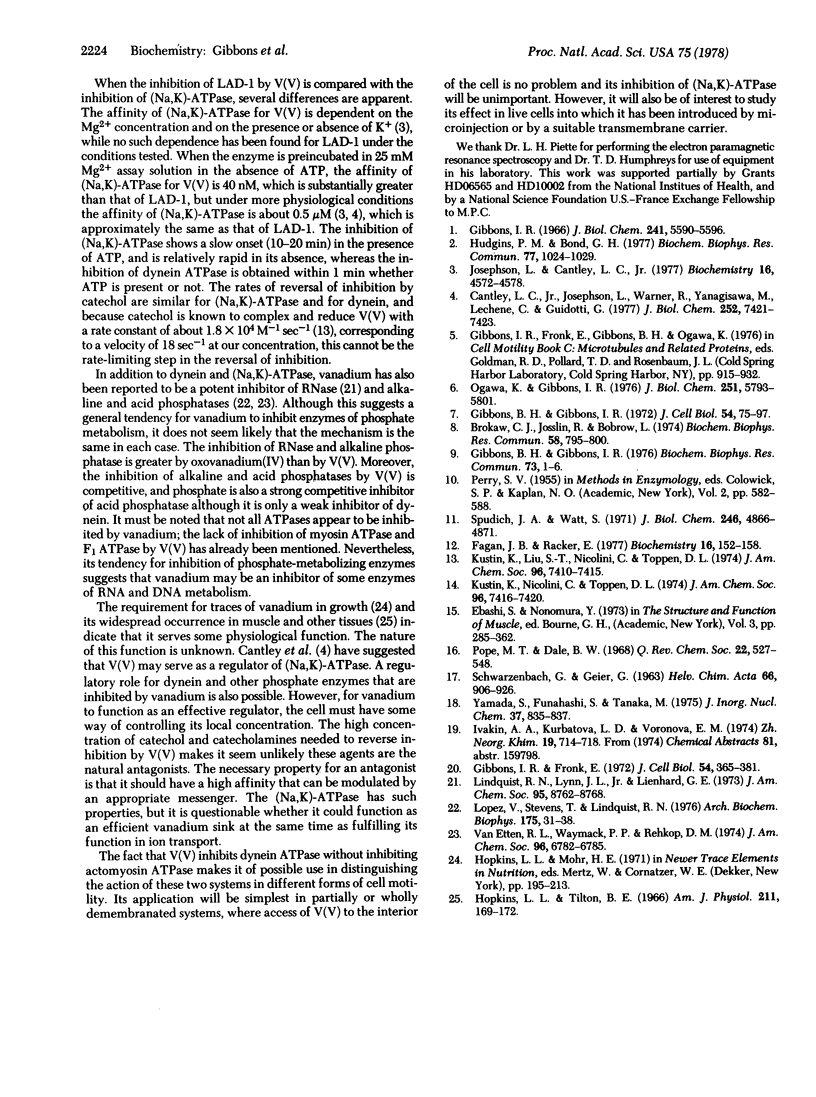Abstract
The motility of demembranated sea urchin sperm flagella and that of embryo cilia reactivated with 0.1 mM ATP are completely inhibited by 4 micron and 0.5 micron vanadium(V) [V(V), in vanadate], respectively. The Mg2+-activated ATPase activity (ATP phosphohydrolase, EC 3.6.1.3)of the latent form of dynein 1 is inhibited 50% by 0.5-1 micron V(V), while the Ca2+-activated ATPase activity is much less sensitive. The inhibition of flagellar beat frequency and of dynein 1 ATPase activity by V(V) appears not to be competitive with ATP. In agreement with other reports, the inhibition of (Na,K)-ATPase by V(V) shows a slow onset in the presence of ATP and is relatively rapid in its absence. With dynein, however, the inhibition occurs at a rapid rate whether or not ATP is present. Catechol at a concentration of 1 mM reverses the V(V) inhibition of reactivated sperm motility, dynein ATPase, and (Na, K)-ATPase. Myosin and actomyosin ATPases show no inhibition by concentrations of V(V) up to 500 micron. The inhibition by V(V) provides a possible technique for distinguishing between the actions of dynein and myosin in different forms of cell motility.
Full text
PDF




Selected References
These references are in PubMed. This may not be the complete list of references from this article.
- Brokaw C. J., Josslin R., Bobrow L. Calcium ion regulation of flagellar beat symmetry in reactivated sea urchin spermatozoa. Biochem Biophys Res Commun. 1974 Jun 4;58(3):795–800. doi: 10.1016/s0006-291x(74)80487-0. [DOI] [PubMed] [Google Scholar]
- Cantley L. C., Jr, Josephson L., Warner R., Yanagisawa M., Lechene C., Guidotti G. Vanadate is a potent (Na,K)-ATPase inhibitor found in ATP derived from muscle. J Biol Chem. 1977 Nov 10;252(21):7421–7423. [PubMed] [Google Scholar]
- Fagan J. B., Racker E. Reversible inhibition of (Na+, K+) ATPase by Mg2+, adenosine triphosphate, and K+. Biochemistry. 1977 Jan 11;16(1):152–158. doi: 10.1021/bi00620a026. [DOI] [PubMed] [Google Scholar]
- Gibbons B. H., Gibbons I. R. Flagellar movement and adenosine triphosphatase activity in sea urchin sperm extracted with triton X-100. J Cell Biol. 1972 Jul;54(1):75–97. doi: 10.1083/jcb.54.1.75. [DOI] [PMC free article] [PubMed] [Google Scholar]
- Gibbons B. H., Gibbons I. R. Functional recombination of dynein 1 with demembranated sea urchin sperm partially extracted with KC1. Biochem Biophys Res Commun. 1976 Nov 8;73(1):1–6. doi: 10.1016/0006-291x(76)90488-5. [DOI] [PubMed] [Google Scholar]
- Gibbons I. R., Fronk E. Some properties of bound and soluble dynein from sea urchin sperm flagella. J Cell Biol. 1972 Aug;54(2):365–381. doi: 10.1083/jcb.54.2.365. [DOI] [PMC free article] [PubMed] [Google Scholar]
- Gibbons I. R. Studies on the adenosine triphosphatase activity of 14 S and 30 S dynein from cilia of Tetrahymena. J Biol Chem. 1966 Dec 10;241(23):5590–5596. [PubMed] [Google Scholar]
- Hopkins L. L., Jr, Tilton B. E. Metabolism of trace amounts of vanadium 48 in rat organs and liver subcellular particles. Am J Physiol. 1966 Jul;211(1):169–172. doi: 10.1152/ajplegacy.1966.211.1.169. [DOI] [PubMed] [Google Scholar]
- Hudgins P. M., Bond G. H. (Mg2+ + K+)-dependent inhibition of NaK-ATPase due to a contaminant in equine muscle ATP. Biochem Biophys Res Commun. 1977 Aug 8;77(3):1024–1029. doi: 10.1016/s0006-291x(77)80080-6. [DOI] [PubMed] [Google Scholar]
- Josephson L., Cantley L. C., Jr Isolation of a potent (Na-K)ATPase inhibitor from striated muscle. Biochemistry. 1977 Oct 18;16(21):4572–4578. doi: 10.1021/bi00640a006. [DOI] [PubMed] [Google Scholar]
- Lindquist R. N., Lynn J. L., Jr, Lienhard G. E. Possible transition-state analogs for ribonuclease. The complexes of uridine with oxovanadium(IV) ion and vanadium(V) ion. J Am Chem Soc. 1973 Dec 26;95(26):8762–8768. doi: 10.1021/ja00807a043. [DOI] [PubMed] [Google Scholar]
- Lopez V., Stevens T., Lindquist R. N. Vanadium ion inhibition of alkaline phosphatase-catalyzed phosphate ester hydrolysis. Arch Biochem Biophys. 1976 Jul;175(1):31–38. doi: 10.1016/0003-9861(76)90482-3. [DOI] [PubMed] [Google Scholar]
- Ogawa K., Gibbons I. R. Dynein 2. A new adenosine triphosphatase from sea urchin sperm flagella. J Biol Chem. 1976 Sep 25;251(18):5793–5801. [PubMed] [Google Scholar]
- Spudich J. A., Watt S. The regulation of rabbit skeletal muscle contraction. I. Biochemical studies of the interaction of the tropomyosin-troponin complex with actin and the proteolytic fragments of myosin. J Biol Chem. 1971 Aug 10;246(15):4866–4871. [PubMed] [Google Scholar]
- VanEtten R. L., Waymack P. P., Rehkop D. M. Letter: Transition metal ion inhibition of enzyme-catalyzed phosphate ester displacement reactions. J Am Chem Soc. 1974 Oct 16;96(21):6782–6785. doi: 10.1021/ja00828a053. [DOI] [PubMed] [Google Scholar]


